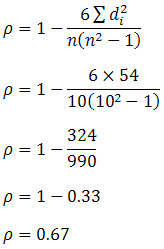Spearman's Rank-Order Correlation (cont...)
What values can the Spearman correlation coefficient, rs, take?
The Spearman correlation coefficient, rs, can take values from +1 to -1. A rs of +1 indicates a perfect association of ranks, a rs of zero indicates no association between ranks and a rs of -1 indicates a perfect negative association of ranks. The closer rs is to zero, the weaker the association between the ranks.
An example of calculating Spearman's correlation
To calculate a Spearman rank-order correlation on data without any ties we will use the following data:
| | Marks |
|---|
| English |
56 |
75 |
45 |
71 |
62 |
64 |
58 |
80 |
76 |
61 |
| Maths |
66 |
70 |
40 |
60 |
65 |
56 |
59 |
77 |
67 |
63 |
We then complete the following table:
| English (mark) | Maths (mark) | Rank (English) | Rank (maths) | d | d2 |
|---|
| 56 | 66 | 9 | 4 | 5 | 25 |
| 75 | 70 | 3 | 2 | 1 | 1 |
| 45 | 40 | 10 | 10 | 0 | 0 |
| 71 | 60 | 4 | 7 | 3 | 9 |
| 62 | 65 | 6 | 5 | 1 | 1 |
| 64 | 56 | 5 | 9 | 4 | 16 |
| 58 | 59 | 8 | 8 | 0 | 0 |
| 80 | 77 | 1 | 1 | 0 | 0 |
| 76 | 67 | 2 | 3 | 1 | 1 |
| 61 | 63 | 7 | 6 | 1 | 1 |
Where d = difference between ranks and d2 = difference squared.
We then calculate the following:
We then substitute this into the main equation with the other information as follows:
as n = 10. Hence, we have a ρ (or rs) of 0.67. This indicates a strong positive relationship between the ranks individuals obtained in the maths and English exam. That is, the higher you ranked in maths, the higher you ranked in English also, and vice versa.
How do you report a Spearman's correlation?
How you report a Spearman's correlation coefficient depends on whether or not you have determined the statistical significance of the coefficient. If you have simply run the Spearman correlation without any statistical significance tests, you are able to simple state the value of the coefficient as shown below:
However, if you have also run statistical significance tests, you need to include some more information as shown below:
where df = N – 2, where N = number of pairwise cases.
How do you express the null hypothesis for this test?
The general form of a null hypothesis for a Spearman correlation is:
H0: There is no [monotonic] association between the two variables [in the population].
Remember, you are making an inference from your sample to the population that the sample is supposed to represent. However, as this a general understanding of an inferential statistical test, it is often not included. A null hypothesis statement for the example used earlier in this guide would be:
H0: There is no [monotonic] association between maths and English marks.
How do I interpret a statistically significant Spearman correlation?
It is important to realize that statistical significance does not indicate the strength of Spearman's correlation. In fact, the statistical significance testing of the Spearman correlation does not provide you with any information about the strength of the relationship. Thus, achieving a value of p = 0.001, for example, does not mean that the relationship is stronger than if you achieved a value of p = 0.04. This is because the significance test is investigating whether you can reject or fail to reject the null hypothesis. If you set α = 0.05, achieving a statistically significant Spearman rank-order correlation means that you can be sure that there is less than a 5% chance that the strength of the relationship you found (your ρ coefficient) happened by chance if the null hypothesis were true.


